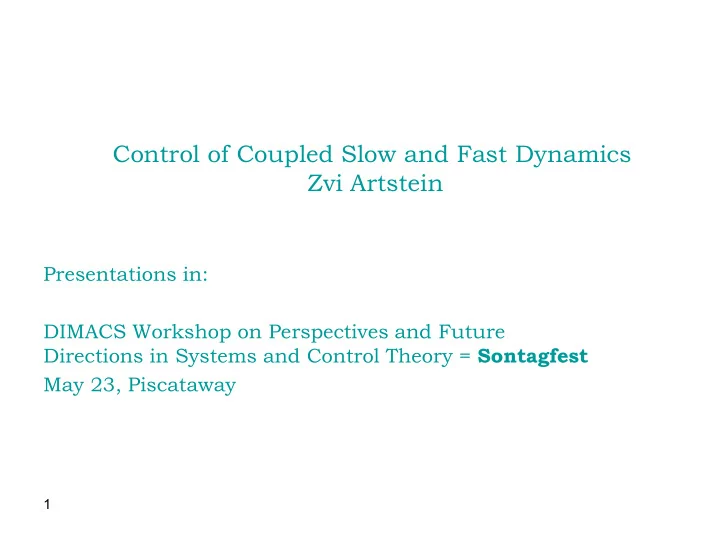

Control of Coupled Slow and Fast Dynamics Zvi Artstein Presentations in: DIMACS Workshop on Perspectives and Future Directions in Systems and Control Theory = Sontagfest May 23, Piscataway 1
Happy Birthday Eduardo Many happy returns! 2
3
Where do coupled slow-fast systems occur? Everywhere! Natural phenomena and engineering design: Hydropower Production, Nuclear Reactions, Aircraft Design, Flight Control, Optical Communiction … Issues include: Regulation, Feedback Design, Stabilization, Optimal Control, … 4
A model: Singularly perturbed control systems: Where: in the slow and in the fast, variables Of interest: The behavior of the system as 5
Petar Kokotovic 6
Andrei Nikolayevich Tikhonov 1906 -1993 7
The order reduction method (Petar Kokotovic et al.) The limit as is depicted by namely, by: 8
The solution method: (y,u) x 1 x 2 9
BUT 10
The general situation: There is no reason why, in general, the optimal fast solution will converge and not, say, oscillate! (y,u) x 1 x 2 11
The remedy: Young measures The limit of a sequence of highly oscillatory functions is the probability-valued map, the Young measure 12
Prior uses of Young Measures in differential equations and control: L.C. Young : Jack Warga : Luc Tartar: John Ball PDEs Generalized Relaxed Material Compensated Curves in the Controls Science Calculus of Compactness Variations 13
The situation in the singularly perturbed case: (y,u) x 1 x 2 The limit solution: 14
A very useful property: An optimal solution always exists! (under a boundedness condition) 15
There is a structure: The values of the Young measure are: invariant measures of the (fast state, control) dynamics ! 16
A study of these invariant measures: As invariant measures of multi-valued maps J.P. Aubin, H. Frankowaska, A. Lasota. Z. Artstein. Characterization via dual variables A. Leizarowirz, V. Gaitsgory 17
An illustration The questions: when should the switch be made? How should this be carried out when the speed is very fast? 18
An example – after V. Veliov 1996 Applying an order reduction (i.e. plugging ) yields zero value. Clearly one can do better! 19
The solution: The limit strategy as can be expressed as a bang-bang feedback resulting in: Limit occupational measure The bang-bang feedback 20
The general limit solution is of the form: Where: solves the averaging equation is an invariant measure (when is fixed) of And the limit cost is Notice, the limit distributions are the control variables , replacing the equilibrium points in the classical case 21
A special case: The state variable is one dimensional Then the Kokotovic approach applies !! (Joint work with Arie Leizarowitz, 2002) 22
Another special case: The state variable is two-dimensional Then it is enough to consider invariant measures on a periodic trajectory (a sort of Poicare-Bendixson result) !! (Joint work with Ido Bright, 2010) 23
Some Propaganda : The method has been applied by Z.A. and collaborators to a variety of applications, including: • Stability and Stabilization • Relaxed Controls • Elimination of randomization • Game theoretic considerations • Quantitative analysis for singular perturbations • Applications to averaging • Invariant measures for set-valued maps • Tracking systems • Linear-quadratic problems • Infinite horizon • Time-varying systems (including fast time-varying) • Optimization via Lagrange multipliers • Value function via Hamilton-Jacobi equations • Linear systems, bang-bang For a discussion of some of these issue please check papers listed in my web page. 24
Collaborators on various applications of Young measures: • Alexander Vigodner*, now in New York, NY • Vladimir Gaitsgory, Adelaida, Australia • Marshall Slemrod, Madison, WI • Cristian Popa*, now in NY (Deutsche Bank) • Michael Grinfeld, Glasgow, Scotland • Arie Leizarowitz, Haifa, Israel • Yannis Kevrekidis, Princeton, NJ • Edriss Titi, Rehovot, Israel • Jasmine Linshiz*, Rehovot, Israel • C. William Gear, Princeton NJ 1953-2010 • Ido Bright*, Rehovot, Israel 25
Work in progress: Singular perturbations of control systems without split to slow and fast coordinates: The perturbed system: Compare with: 26
The general situation without slow-fast split: u z 1 z 2 27
Identifying slow and fast contributions : Fast equation: The perturbed system: 28
The limit solution: As the limit (in the sense of Young measures) of the solution of the perturbed system: is an invariant measure of the fast equation: drifted by the the slow component. 29
The trajectory of invariant measures: The drift (change in time) of the measures is determined by generalized moments, or observables, preferably first integrals of the fast equation: The dynamics of the observables satisfies: The novelty: The observables are not part of the state space. 30
An example (without a control)*: With W. Gear, I. Kevrekidis, E. Titi, M. Slemrod With periodic boundary conditions. This is the Lax-Goodman discretization of the KdV-Burgers with periodic boundary conditions * from a paper to appear in SIAM J. Numerical Analysis 31
The first integrals of the fast equation: are the traces of the so called Lax pairs – these are computable even polynomials Computing the dynamics of these time-varying polynomial enables the construction of the drift of the invariant measures 32
Computational results for an invariant measure*: for the limit as * from the paper to appear in SIAM J. Numerical Analysis 33
Computational results for the drifted measure*: for the limit as * from the paper to appear in SIAM J. Numerical Analysis 34
The End Thanks for the attention All the best, Eduardo ! 35
Recommend
More recommend